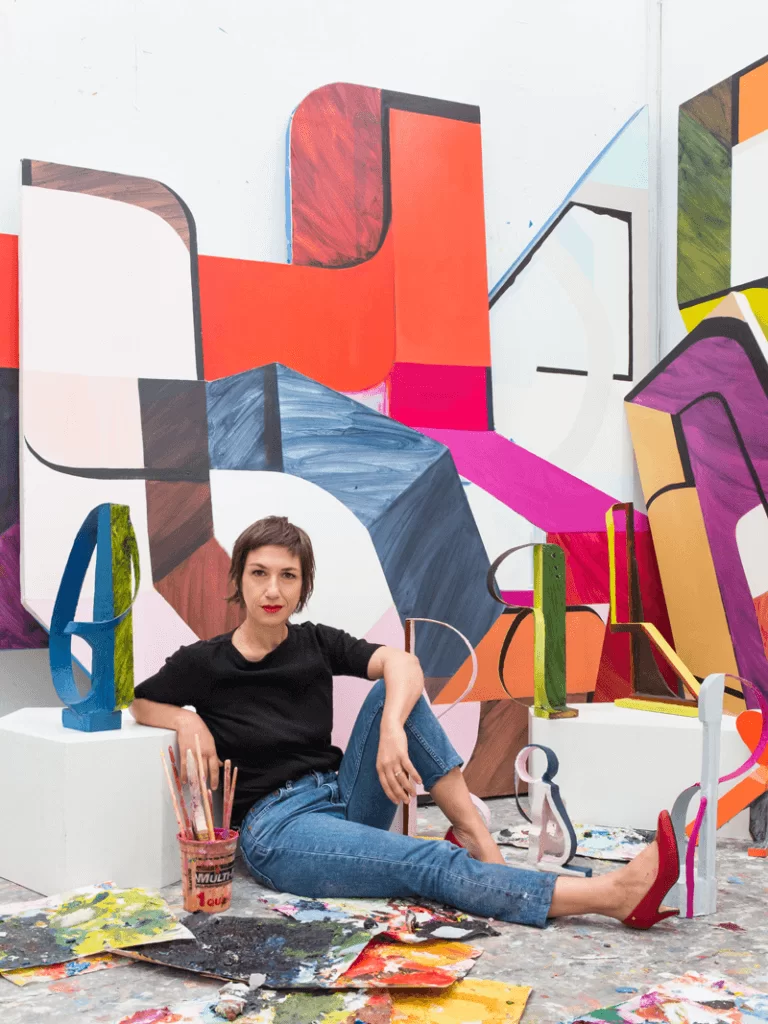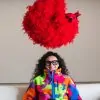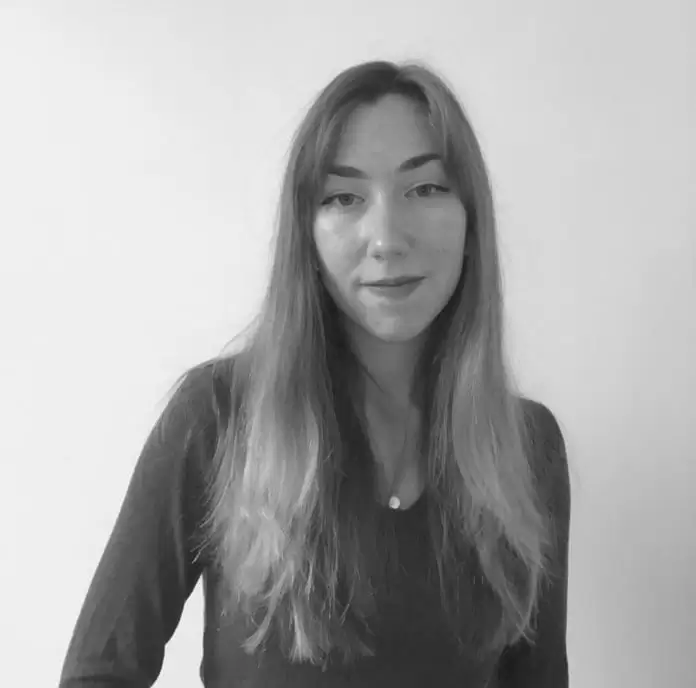Rebekah Goldstein never stops building. The San Francisco-based painter and sculptor presents even her most complete works as continuously under construction. Goldstein is involved in a never-ending studio practice of assembling parts and pieces pulled from the body, architecture, and art history into perspective-bending corporal compositions.
I make paintings that explore colour, form, and structure and their relationship to the human body and the built environment.
Rebekah Goldstein
Her work references the human form and plays with our perceptions of space, environment, and physicality. Most recently, Goldstein’s practice has incorporated the artist’s changed relationship to the body and the ever-shifting walls of our anatomy.
Treating the canvas as body and vice versa, Rebekah Goldstein’s most recent series of works features both painting and sculpture, which manipulate shape and form more than ever before. In an upcoming solo show at CULT Aimee Friberg Exhibitions, sculptural canvases conflate crooked joints with dramatic corners, and 3-dimensional artefacts challenge notions of gesture and gravity.
The show balances Goldstein’s personal arc throughout the past two years with broader notions of the human body. The collection inspires reflection on our relationships to the forms and figures that shape us and surround us. Rebekah Goldstein is in the business of introducing the world, and the worlds within ourselves, as consistently under construction.
Rebekah Goldstein’s upcoming solo exhibition, ‘Welcome Home Stranger,’ opens 18 March 2022 at CULT Aimee Friberg Exhibitions in San Francisco.
Q: You have an upcoming exhibition which is entirely composed of new work. For those of us who are new to your practice, can you share a little bit about your background and who you are as an artist?
A: I grew up in San Jose, California and went to Sarah Lawrence College in New York, where I studied painting. After travelling and moving around for a few years, I moved back to California to do an MFA at California College of the Arts in San Francisco. I still live and work in San Francisco.
I make paintings that explore colour, form, and structure and their relationship to the human body and the built environment. I have always been a painter, and for the last few years, I’ve been making sculptures. In both my paintings and sculptures, I create structures through a process of improvisation and reiteration.
Although my paintings may initially appear abstract, each piece is filled with a wide array of visual references — art historical paintings, images of architecture, textures, colour combinations, furniture, and textiles. I consider the formal elements of my work — the shapes, colours, lines, and brushwork — to create a type of visual lexicon that I’ve been building.

Oil on shaped canvas
49 x 69 inches
Courtesy of the artist and CULT Aimee Friberg Exhibitions.
Q: Your upcoming exhibition with CULT Aimee Friberg Exhibitions was conceived throughout the past two years and explores notions of form and gesture. What inspired this body of work, and why did you decide to embark on this series?
A: When I began this body of work, shaped canvases were pretty new for me. With each piece having such a unique shape and being at a human scale, the form of the paintings called to mind figures and poses. As I began working on each piece, I would have a specific physical gesture in mind. For example, there are two paintings that allude to the art historical ‘contrapposto’ pose, in which the body’s weight rests on one engaged leg while the other more relaxed leg bends at the knee. Other paintings reference an odalisque-type pose, while others suggest hand gestures.
I was intrigued by the idea of both paintings and figurative gestures as ways of indirect communication — both communicate without language, are full of nuance, and are open to interpretation. Just as the gesture has an implied sentiment but no fixed meaning, the painting also opens up to a diverse range of idiosyncratic innuendos, latent emotions, and implied connotations.
While working on the paintings, I simultaneously began a new series of sculptural works. There is so much overlap between the shapes and forms in the paintings and sculptures. The ability for sculptures to reference the paintings and vice versa was an important source of inspiration. The potential for metamorphosis as the forms move between two and three dimensions has been an ongoing exploration. Still, it gained new meaning as the paintings took on such figurative connotations. The paintings and sculptures seemed more linked to my body and my personal shifts and transformations.
I began this work right after my son was born; my eldest was barely two. I found so much freedom in making work while no longer pregnant, feeling back at home in my body — yet also feeling that I had transformed in ways that I could not put words to.
This body of work, like all bodies of work for me, developed intuitively. It wasn’t until I was deep into these paintings that I started noticing these larger arcs of meaning. What drives the paintings simply is the desire to paint. Especially because I had a baby and a toddler at home, I felt an urgency to make these paintings, to get in the studio and make my work without overthinking.
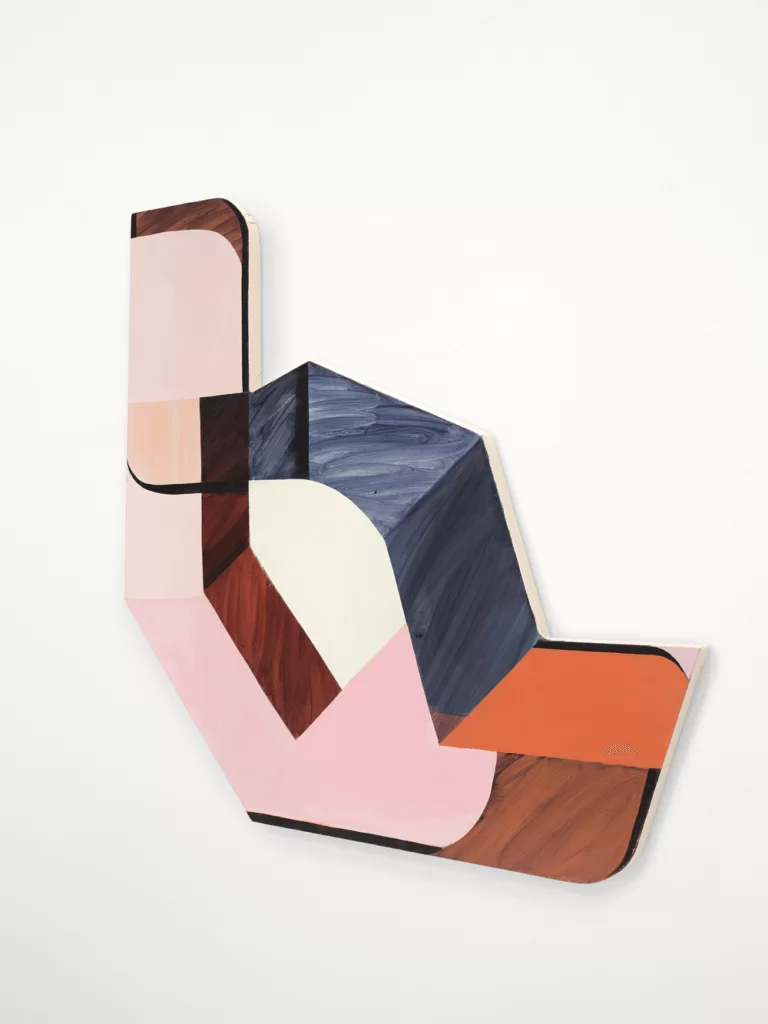
Oil on shaped canvas
66 x 67 inches
Courtesy of the artist and CULT Aimee Friberg Exhibitions.
Q: Your practice involves both painting and sculpture, how do you navigate working in two different art forms at once and how did you develop your practice to include this combination of media?
A: I have always been a painter, and over time I’ve discovered sculpture. There have often been very structural elements to my paintings — I’ve said that my paintings depict imagined structures and space. Several years ago, I began to wonder what the imagery in my paintings would look like if it was an object.
When I began making sculptures, it was very important that my sculptural process was similar to my painting process. My paintings are entirely unplanned and improvisational. I don’t sketch them out in any way, and when I begin, I have no idea what the end result will look like. I have a process of responding to previous layers, building up an image, then reworking it in a way that feels like taking it apart. So I needed a sculptural process that allowed for a lot of trial and error.
I begin my sculptures by building an armature with various materials — found wood, linoleum, and foam. These materials are all very malleable, and much like my painting, I spend a lot of time assembling and reworking. Once the armature is created, they are then coated in papier-mache.
Because the painting and sculpture processes mirror each other, having both in progress in my studio feels very natural and fluid to me. In fact, it is a very iterative process. The imagery in my paintings informs my sculptures, which influences the imagery in my paintings. Making both painting and sculpture has given me a fuller appreciation for what each can do. For me, the thrill of painting is its ability to create illusion — the imagery can defy gravity, bend perspective, create its own laws of perspective. Yet sculpture offers me a concrete way to create form, view space, and apply colour.

Wood, linoleum, foam, papier mache, molding paste, oil paint
Courtesy of the artist and CULT Aimee Friberg Exhibitions
Q: Your work can be seen as highly interrogative towards representations of the human form. What is your reasoning behind the use of abstracted, often geometric, forms in your work? How are your subject and visual language linked?
A: The abstracted geometric shapes that I use in my work speak to the fluidity of form and have many reference points. They allude to abstracted human figures, architecture, furniture, and landscape. Although my paintings do not depict figures in a traditional sense, they reference the body in scale, gesture, and form. While each painting may, for example, reference a pose, the painting ultimately creates an illusionistic space. And with that illusion comes multiple perspectives, shifting figure and ground, advancing and receding planes of colour — an image that shifts and transforms. An angle that could be seen as a loop of an arm on a hip, could also be seen as a window or door.
I’m interested in images that can be interpreted in multiple ways that shift the longer you look at them. This type of visual language allows the viewer to situate themselves in reference to the piece and consider their own orientation to the surrounding environment. They draw the viewer’s awareness to how they physically and emotionally interact with a given space.
My paintings are also made in reference to my body in a very specific way. My own experiences with pregnancy and childbirth created an awareness of my shifting body. I was fascinated, repulsed, curious by the nuances of each change. There was a personal intimacy of feeling my body change. The puzzle of it. The particulars of it. Of course, this isn’t limited to pregnancy — our bodies are constantly shifting and changing. As a result, we have to constantly renegotiate our relationship to our bodies and our body’s relationship to the surrounding world.
This constant reorientation is mirrored in my paintings. Just as I ask myself, “what is my relationship to my body” I try to create paintings that raise questions for which there are no straightforward answers. “What am I looking at? What angle am I looking at it from? What is its scale? How is it holding itself together?” While these questions may seem formal, they are metaphors for how we look at the world around us, how we feel in our bodies, and how we orient ourselves to a given environment.
Q: What was it like working on this series throughout the pandemic? Were there any unexpected benefits or drawbacks? How did working through this particular moment in time influence your work?
A: Working during the pandemic was meaningful, purposeful, and therapeutic for me. I embraced the solitude of being alone in my studio. While I love having studio visits, participating in shows, and going to openings, there was something compelling about not doing any of that and focusing entirely on my work, just being alone with my paintings and myself in the studio. It allowed me to be honest about what I wanted from my paintings. To spend a longer time sitting with the work. To take risks and rework paintings.
I’ve always had the habit of changing and reworking paintings, but that process really took precedence in this body of work. I would “finish” a painting, and if I had the slightest doubt if anything could or should be changed, I would rework it completely. Change the colour palette, the orientation, the composition. My mantra was, “Make a better painting.” Each time I reworked the painting, I ultimately got it to a stronger place. During such a tumultuous time, there was a lot of empowerment in the process of simultaneously changing everything yet also building on what was already there. There was empowerment in the solitude, in painting while no one was looking.

Oil on shaped canvas
66.5 x 48 inches
Courtesy of the artist and CULT Aimee Friberg Exhibitions.
Q: How did the idea to create your paintings using shaped canvases come about? Is there any additional significance to the fact that your painting surface is so nontraditional and unique? What is the process of conceiving these forms like?
A: I began making shaped paintings after the birth of my first child. My body, my brain, and my paintings all went through a metamorphosis. After nine months of my own shape transforming, the rectangle no longer made sense. If the human body could shift and transform so drastically, so could my paintings. I had always considered the imagery in my rectangular paintings to be depictions of structures. Now the structures became the form of the canvas itself, and each painting needed its own specific shape. Perhaps the form of the painting had become increasingly important because I had, in a sense, become an armature. I was the structure that provided the physical support of another being.
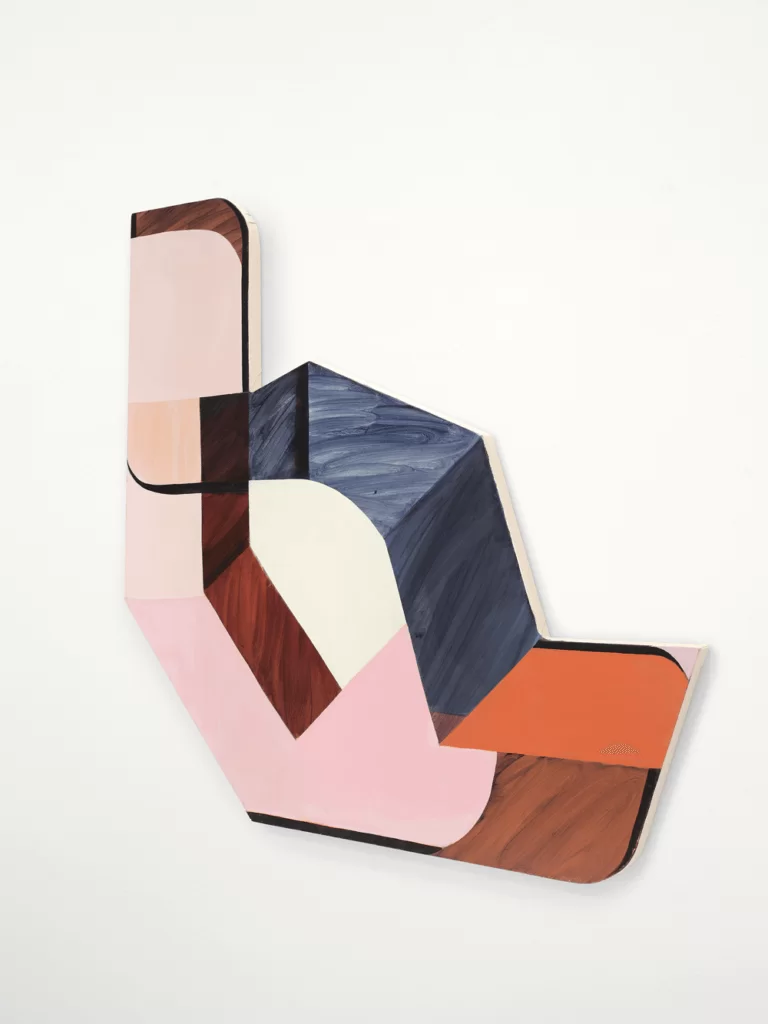
Oil on shaped canvas
60 x 62 inches
Courtesy of the artist and CULT Aimee Friberg Exhibitions.
To begin, I use blue painter’s tape to create the contour of a shape on the wall of my studio. It’s a very intuitive process. I try to create a shape that has the right amount of tension, that speaks to forms in previous paintings yet feels fresh. The tape allows for a lot of adjusting, and I spend a lot of time just looking. When I arrive at a shape that feels “right,” I make a full-scale paper template which I mail to my incredible stretcher bar builder, Charlie Schwartzerburg. He builds them for me, and I stretch them.
I Iike to have as many canvases as possible in process simultaneously. When I work on several at a time a dialogue builds between them. As I mentioned, I don’t plan out the paintings in any way. I had a specific gesture or pose in mind as a reference point for those in this exhibition, but as soon as I start painting, I like to “forget” about it. The source imagery is kept back of mind, or perhaps another image will start to take precedent. As I work on them, they change orientation, change colour palette, change composition. This process itself is a central inspiration in this body of work — building up, changing, shifting, transforming.
The shaped canvas is such a natural meeting point between my rectangular paintings and sculptures. It has the feeling of being an object, yet it still has the surface of a painting. I can change everything about the surface of the painting while working on it, but I still have this very specific form to contend with. It feels like searching for the image that will fit the form, almost like completing a puzzle.
Q: What are you hoping viewers will be left thinking about when they visit the show this spring?
A: I’m hoping the viewer will be left thinking, “Those are the best paintings I’ve ever seen!” At the end of the day, isn’t that the point of putting a show together?
I’m also hoping that viewers will feel the need to go back and look again. The paintings in the show take revisiting. They have an initial visual punch but then slowly open up and reveal more. The paintings play with perspective and appear to shift from different corners of the room. While each painting holds many references for me, there is a lot of room for viewers to form their own interpretations and connections.
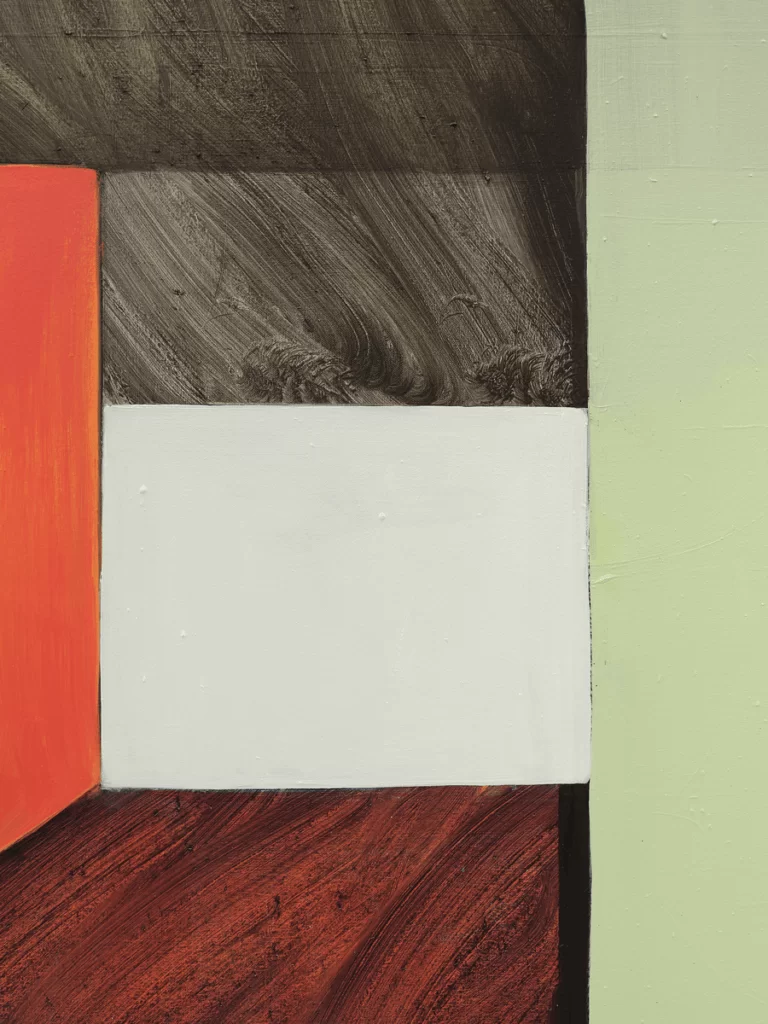
Oil on shaped canvas
62 x 86 inches
Courtesy of the artist and CULT Aimee Friberg Exhibitions
Q: Why do you feel it’s important to continue to push conversations about form and representation in art to the forefront?
A: I think there is a human desire to recognize ourselves and see ourselves reflected in whatever we look at. Yet, at the same time, art can push beyond what is recognizable to help us see beyond what we already know. Often representation and abstraction are seen in opposition to each other, but obviously, a lot of work exists between the two. There is a lot of room to broaden what is considered representation or what can be depicted.
Can representation also encompass what we feel or what we know with our bodies? Often work that deals with that is considered to be “abstract.” But why not rethink that? Painting can allow for ways of seeing that go beyond what we are familiar with, that go beyond what we have language for. When we push the idea of what we consider representation, we are opening ourselves up to a broader, more imaginative, nuanced way of seeing.
Q: Where do you see your practice taking you next?
A: I plan to continue my exploration of shaped canvases. I want the opportunity to work in a site-specific way and respond to the architecture of a building or environment. I would also like to create more large-scale sculptures. I had one of my sculptures fabricated in steel for this show, which I then hand-painted. It’s almost six feet high, and I love the way human-scaled sculpture interacts with my paintings. I think there are many opportunities to play with the installation of the sculptures and paintings as well. But most importantly, just getting back into the studio, making work, and seeing where it takes me.
https://www.instagram.com/rebekahgoldstein
©2022 Rebekah Goldstein



